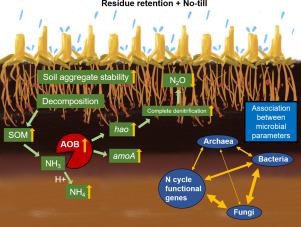当前位置:
X-MOL 学术
›
Appl. Soil Ecol.
›
论文详情
Our official English website, www.x-mol.net, welcomes your
feedback! (Note: you will need to create a separate account there.)
Long-term residue removal under tillage decreases amoA-nitrifiers and stimulates nirS-denitrifier groups in the soil
Applied Soil Ecology ( IF 4.8 ) Pub Date : 2021-01-01 , DOI: 10.1016/j.apsoil.2020.103730 N. Kim , C.W. Riggins , S. Rodríguez-Zas , M.C. Zabaloy , M.B. Villamil
Applied Soil Ecology ( IF 4.8 ) Pub Date : 2021-01-01 , DOI: 10.1016/j.apsoil.2020.103730 N. Kim , C.W. Riggins , S. Rodríguez-Zas , M.C. Zabaloy , M.B. Villamil

|
Abstract No-till in continuous corn (Zea mays L.) production helps to keep an important volume of residues on the soil surface, creating management challenges that could be alleviated by residue removal for bioenergy or animal use. Crop residues, however, are essential to stimulate microbial nutrient cycling in agroecosystems. Thus, both residue removal and tillage options need to be fully evaluated for their impacts on ecosystem services related to soil health, including microbial N cycling. We explored the main steps of the microbial N cycle in relation to soil properties by using targeted gene abundance as a proxy following over a decade of residue removal in continuous corn systems either under no-till or chisel tillage. We used real-time quantitative polymerase chain reaction (qPCR) for the quantification of phylogenetic groups and functional gene screening of the soil microbial communities, including genes encoding critical enzymes of the microbial N cycle: nifH (N2 fixation), amoA (nitrification – ammonia oxidation), nirK and nirS (denitrification – nitrite reduction), and nosZ (denitrification – nitrous oxide reduction). Our results showed that long-term residue removal and tillage decreased soil organic matter (SOM), water aggregate stability (WAS), and the relative abundance (RA) of ammonia-oxidizing bacteria (AOB) carrying nitrifying amoA genes. Denitrifiers carrying nirS genes decreased under no-till as crop residue was removed. In addition, our results evidenced strong correlations among soil properties and phylogenetic groups of bacteria, archaea, and fungi. Overall, this study demonstrated limited but definite impacts of residue management and tillage on the soil environment, which could be exacerbated under less resilient conditions.
中文翻译:

长期在耕作下去除残留物会减少 amoA-硝化菌并刺激土壤中的 nirS-反硝化菌群
摘要 连续玉米 (Zea mays L.) 生产中的免耕有助于在土壤表面保留大量残留物,从而产生管理挑战,可通过去除残留物用于生物能源或动物用途来缓解这些挑战。然而,作物残留物对于刺激农业生态系统中的微生物养分循环至关重要。因此,需要充分评估残留物清除和耕作方案对与土壤健康相关的生态系统服务的影响,包括微生物氮循环。我们通过使用靶向基因丰度作为代理,在免耕或凿耕的连续玉米系统中去除残留物十多年后,探索了与土壤特性相关的微生物氮循环的主要步骤。我们使用实时定量聚合酶链反应 (qPCR) 对土壤微生物群落的系统发育群进行量化和功能基因筛选,包括编码微生物 N 循环关键酶的基因:nifH(N2 固定)、amoA(硝化 - 氨氧化)、nirK 和 nirS(反硝化 - 亚硝酸盐还原)和 nosZ(反硝化 - 一氧化二氮还原)。我们的结果表明,长期的残留物清除和耕作降低了土壤有机质 (SOM)、水团聚体稳定性 (WAS) 和携带硝化 amoA 基因的氨氧化细菌 (AOB) 的相对丰度 (RA)。随着作物残留物的去除,携带 nirS 基因的反硝化菌在免耕下减少。此外,我们的结果证明土壤性质与细菌、古细菌、和真菌。总体而言,这项研究表明残留物管理和耕作对土壤环境的影响有限但明确,在弹性较差的条件下可能会加剧这种影响。
更新日期:2021-01-01
中文翻译:

长期在耕作下去除残留物会减少 amoA-硝化菌并刺激土壤中的 nirS-反硝化菌群
摘要 连续玉米 (Zea mays L.) 生产中的免耕有助于在土壤表面保留大量残留物,从而产生管理挑战,可通过去除残留物用于生物能源或动物用途来缓解这些挑战。然而,作物残留物对于刺激农业生态系统中的微生物养分循环至关重要。因此,需要充分评估残留物清除和耕作方案对与土壤健康相关的生态系统服务的影响,包括微生物氮循环。我们通过使用靶向基因丰度作为代理,在免耕或凿耕的连续玉米系统中去除残留物十多年后,探索了与土壤特性相关的微生物氮循环的主要步骤。我们使用实时定量聚合酶链反应 (qPCR) 对土壤微生物群落的系统发育群进行量化和功能基因筛选,包括编码微生物 N 循环关键酶的基因:nifH(N2 固定)、amoA(硝化 - 氨氧化)、nirK 和 nirS(反硝化 - 亚硝酸盐还原)和 nosZ(反硝化 - 一氧化二氮还原)。我们的结果表明,长期的残留物清除和耕作降低了土壤有机质 (SOM)、水团聚体稳定性 (WAS) 和携带硝化 amoA 基因的氨氧化细菌 (AOB) 的相对丰度 (RA)。随着作物残留物的去除,携带 nirS 基因的反硝化菌在免耕下减少。此外,我们的结果证明土壤性质与细菌、古细菌、和真菌。总体而言,这项研究表明残留物管理和耕作对土壤环境的影响有限但明确,在弹性较差的条件下可能会加剧这种影响。











































 京公网安备 11010802027423号
京公网安备 11010802027423号